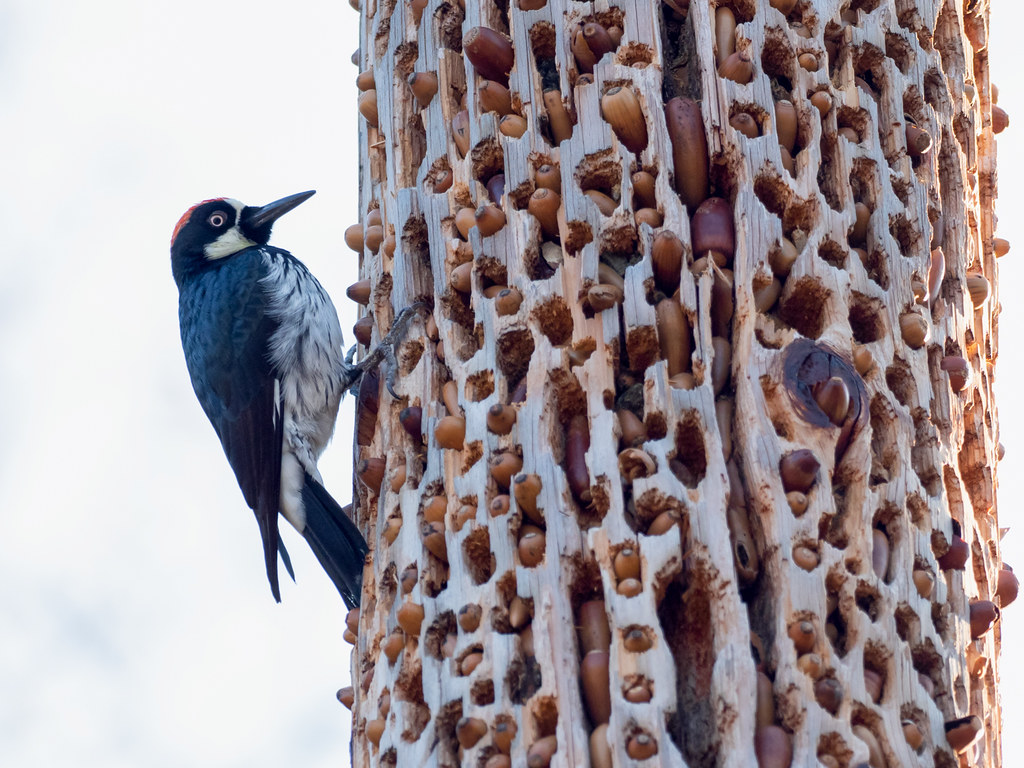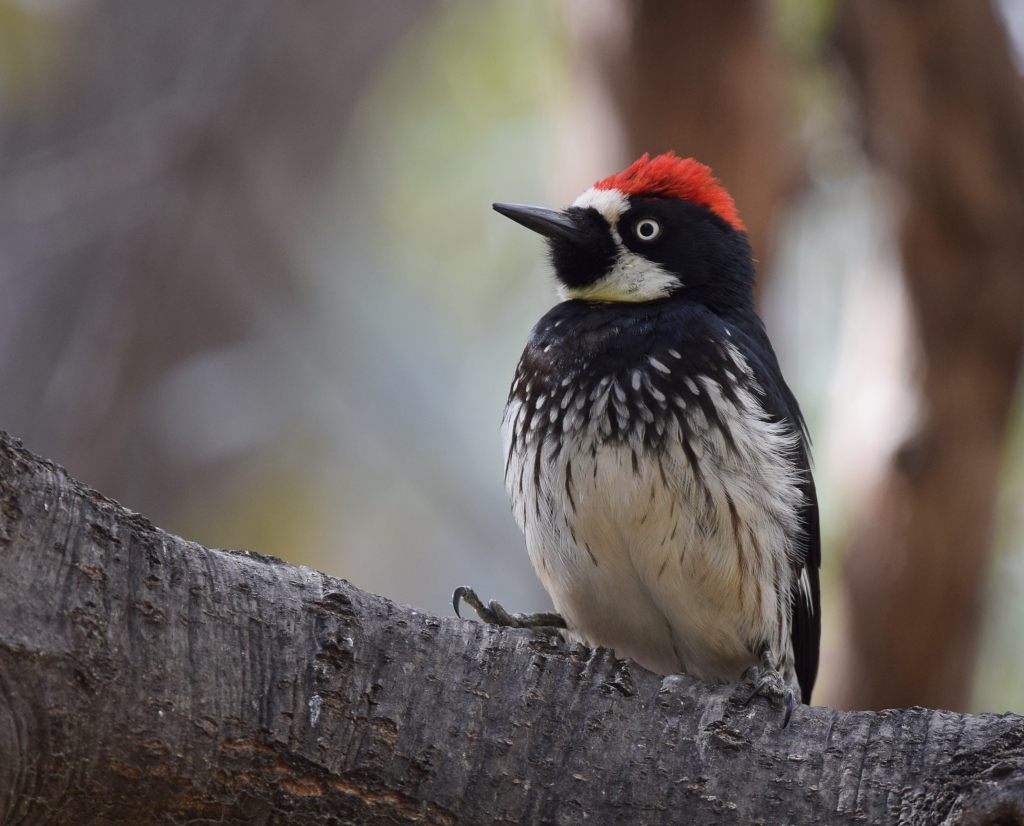This article is a modified excerpt from the author’s upcoming book, “Are You There God? It’s Me, Darwin.”
Cannibalism at the Co-Op
In the early spring mists of the California coast, deep within hilly oak and evergreen forests, their voices cut through the morning air. Calls emerge from somewhere in the treetops, ascending in pitch and volume:
“Ackah, Ackah, Ackah! ACKAH!”
Even if you can’t spot an acorn woodpecker (Melanerpes formicivorus) — wide-eyed and black and white with a brilliant red cap — signs of its activity abound. The trees in their territory are peppered with holes, indentations made by generations of careful bark drilling to provide storage space for — what else? — acorns. While acorn woodpeckers eat insects, flowers, and berries when the weather is warm, they rely heavily on their acorn stockpiles to make it through the winter. As such, the pockmarked trees these woodpeckers live and work in are called granaries. Out of all the bird species we know, acorn woodpeckers are the only ones that make granaries in this way.

Most birds nest in pairs with one male and one female. Acorn woodpeckers are unusual in this way. They are highly communal, usually nesting in groups of up to twelve individuals, almost always composed of close relatives. It’s a family affair. Each member of the nest contributes to finding food, caring for the young, and defending their shared territory [1]. Turf wars are common, with neighboring groups frequently jostling for granary trees. Researchers have observed long, brutal conflicts in which groups of acorn woodpeckers jab at each other relentlessly with their spear-like beaks over control of a tree [2]. The price of victory may be worth it. After all, it’s far faster to grab a granary that’s already been installed than to make a new one from scratch.
This behavior makes sense given what we know about evolutionary biology. The important factor at play for the woodpecker’s communal nesting is kin selection. One integral part of evolutionary biology is the idea of fitness, which is an individual’s ability to pass on their genes to the next generation. But think about it: where did your genes come from? Your parents. And what about them? Their parents. Chances are, some of your relatives have siblings or children of their own. You and your close relatives will carry many of the same genes, and at the end of the day, that is what counts. Even if I do not end up having children, if my sister has children, or even my cousin, a lot of my genes will still get passed along. If life continues by passing along genes, it therefore benefits me to help my siblings care for their children. If I’m old enough to help but too young to get a mate of my own, helping my parents care for new children would also be a great way to ensure the continuation of our genetic lineage. Helping my parents raise an additional kid actually gives the same genetic benefit as having a kid myself. That, in an acorn shell, is kin selection, and it explains why helping family members can be such a powerful evolutionary force in the animal kingdom.
In fact, just around half of the members of an acorn woodpecker group contribute directly to reproduction at any given time, while the rest help care for nestlings. When breeding female acorn woodpeckers lay eggs, they often do so in a single communal nest with the rest of their sisters. When the eggs hatch, the young are equally cared for by the group. Group parenting sounds like a great, cohesive system, but it makes it all the more surprising to learn that female acorn woodpeckers readily and enthusiastically destroy and cannibalize each other’s eggs [3].
Whether you call this true cannibalism or not — I do — there’s one thing we can all agree on: eating your sister’s developing child is not very nice. Moreover, it makes nesting with your siblings sound like a horrible idea. Why the heck would you want to raise a child with your siblings, if there’s a good chance they eat it before it even has a chance to hatch? Well, as it turns out, there may be an evolutionary reason: timing is everything.
In the 1990s, famed research zoologist Walter Koenig and his research team at Hastings Nature Reserve studied this bizarre behavior in detail, making careful note of which eggs were consumed, when, and by whom. The team found three key pieces of information. First, a shocking 80% of eggs laid on the first day of a laying bout (making up 38% of the total!) were destroyed and eaten– egg-eating took place when only one of the two laying females had laid eggs in the nest. As soon as multiple females laid eggs in the nest on the same day, egg-eating basically stopped. Second, rather than becoming furious with the siblings eating her eggs, the female that laid them would even join in, devouring them with the rest of her relatives. Third, egg-hatching takes place over an extremely narrow time frame of around 24 hours [4].
Considering what we know about natural selection, the thought of an animal not just allowing, but joining in the eating of her own eggs makes little sense. It sure doesn’t seem to make sense from a kin selection standpoint. What are these birds up to? Let’s consider the evidence from Koening’s team. Egg cannibalism stops when females sync up their egg-laying [4]. There seem to be two causes at work here. One might be that the woodpeckers have a hard time telling which egg is theirs, but that fails to explain the wide prevalence of egg cannibalism in the first place. Wouldn’t they just play it safe and not eat any of the eggs? The second and more important cause is probably this: it’s more equal when every egg hatches around the same time.
Many bird parents play favorites. Often the healthiest, strongest-looking chicks are given an unfair share of resources, because they have a better chance of surviving to adulthood than their siblings [5]. Being a late nestling does not provide an easy start in life. If an acorn woodpecker chick, or clutch of chicks, hatches early, they have a massive advantage over the later arrivals in terms of feeding priority and survival chances. By consuming early-laid eggs, acorn woodpeckers work to avoid this inequality, and in return, the chicks that hatch together benefit from the extra care they receive from the group. Kin selection can play a powerful role, but it’s not all-powerful. It doesn’t stop familial rivalries over favoritism. Perhaps, in order to encourage communal chick-rearing, every woodpecker mom needs the guarantee that her kids will receive the same amount of attention and have roughly the same chance of survival as any other. Without that guarantee, why not just focus on your own offspring? In a bizarre twist, it’s possible that rather than egg cannibalism threatening the stability of the acorn woodpecker nest, it contributes to it.
Egalitarian egg cannibalism may seem bizarre to us, but the numbers don’t lie – it works. Even the very bird that laid the egg seems to “understand” that the early egg must get the beak. Here is an example of wonderfully complex cooperation in the acorn woodpecker, the result of a balancing act between selfishness and altruism. Most human families can relate. Not to the cannibalism part (hopefully), but to that “balancing act” it comes from.
After nearly two years of living in California, my ears still perk up whenever I hear that strange, cackling call go up in the trees around me. I’ll see one flit by in a black-and-white blur, its beak filled with an acorn, nesting material, or some other bits that I hope aren’t eggshells. As much as I respect their species’ parenting strategy, I think I prefer ours. If I was born an acorn woodpecker, it’s likely I would have been eaten right from the get-go, possibly by my own mother. Just another reason to call my mom and thank her this Mother’s Day.

Jacob Johnson is a second-year animal behavior PhD student at UC Davis studying how animals respond to rapid environmental changes. When he’s not chasing birds or ants, he enjoys playing jazz saxophone, running board game nights, and writing about nature. His first book, Are You There God? It’s Me, Darwin will be available late next year.
References
[1] Mumme, R. L., Koenig, W. D., & Pitelka, F. A. (1990). Individual Contributions to Cooperative Nest Care in the Acorn Woodpecker. The Condor, 92(2), 360–368. https://doi.org/10.2307/1368233
[2] Sneed, A. (2020). Acorn Woodpeckers Fight Long, Bloody Territorial Wars. Scientific American. Retrieved May 3, 2022, from https://www.scientificamerican.com/podcast/episode/acorn-woodpeckers-fight-long-bloody-territorial-wars/
[3] Mumme, R. L., Koenig, W. D., & Pitelka, F. A. (1983). Reproductive competition in the communal acorn woodpecker: Sisters destroy each other’s eggs. Nature, 306(5943), 583–584. https://doi.org/10.1038/306583a0
[4] Koenig, W. D., Mumme, R. L., Stanback, M. T., & Pitelka, F. A. (1995). Patterns and consequences of egg destruction among joint-nesting acorn woodpeckers. Animal Behaviour, 50(3), 607–621. https://doi.org/10.1016/0003-3472(95)80123-5
[5] Brode, M., Miller, K. D., Atkins Coleman, A. J., O’Neil, K. L., Poole, L. E., & Bowers, E. K. (2021). Parental favoritism in a wild bird population. Animal Cognition, 24(4), 677–687. https://doi.org/10.1007/s10071-020-01463-3
[Edited by Meredith Lutz]